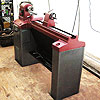David,
the motor on my 14" bandsaw [Tiawanese} went out, I replaced it with a baldor with identical spec............no comparrison......the baldor just has so much more torque and will cut through a piece of wood that the other motor that came with the saw would stall with............American made, baby...........gotta love it!





 Reply With Quote
Reply With Quote






